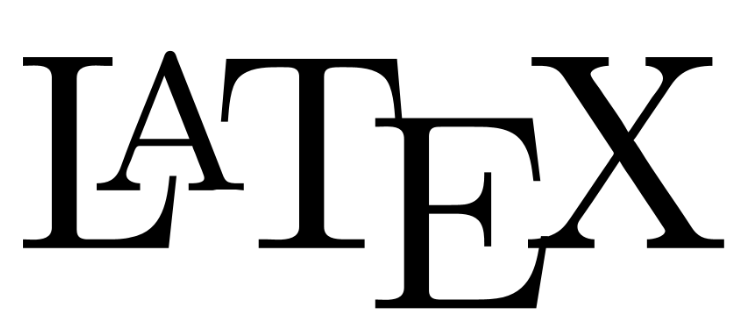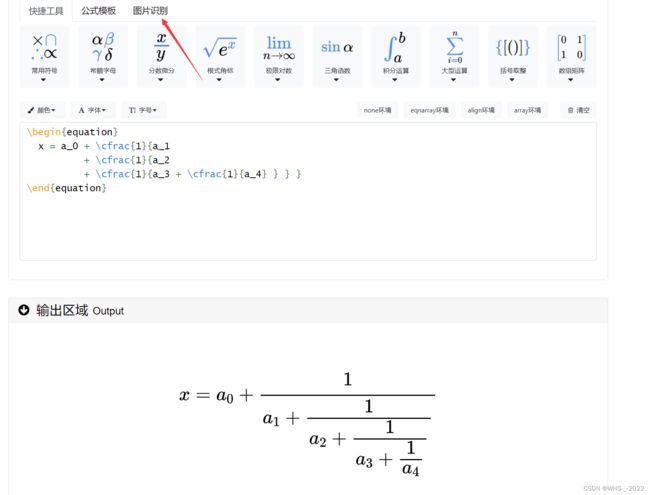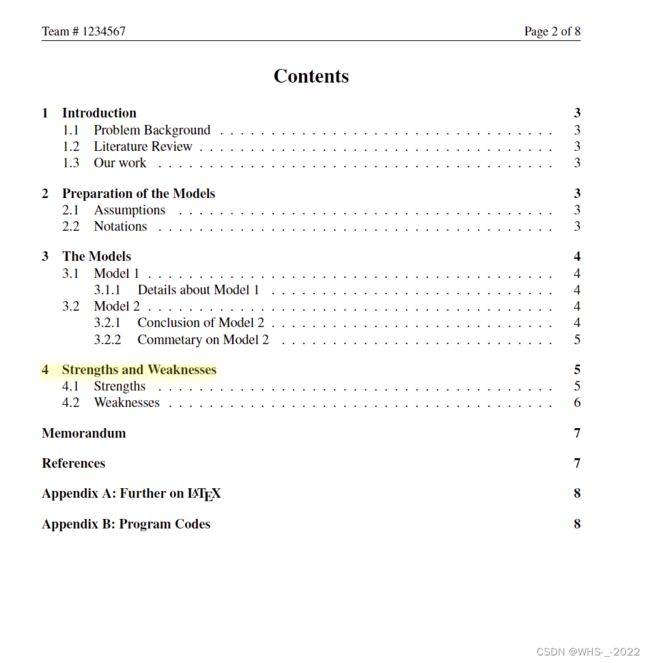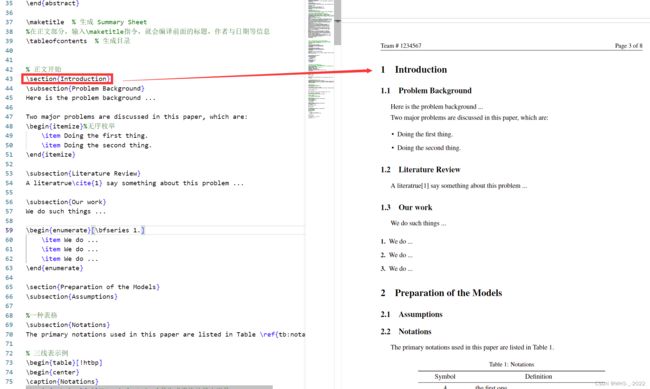LATEX模板总结
写本篇文章的目的在于记录一下自己学习的亚太杯建模LATEX论文排版过程,模板是从一位西交前辈的个人网站得来的首页 · Heishan Press,这位大佬的博客当中有很多有意思的内容,大家可以去研读一下。
目录
一、公式部分
二、 文档开头的宏定义
三、文章的各个部分
1、摘要
2、目录
3、正文部分
四、代码
一、公式部分
建模最重要的就是公式的编写了,我们可以利用在线的可视化LATEX公式编辑器大大降低难度,网址如下在线LaTeX公式编辑器-编辑器。它甚至贴心的提供了图片识别功能。
在这里我务必要推荐一下VSCODE的LATEX编辑器,鼠标悬停在代码上方就可以查看效果,值得推荐,至于如何配置VSCODE可以看我的另一篇文章。
这种是插入文段的公式,通常我们需要\begin{equation}和\end{equation}搭配使用,代码如下
\begin{equation}\label{eq:heat}
\frac{\partial u}{\partial t} - a^2 \left( \frac{\partial^2 u}{\partial x^2} + \frac{\partial^2 u}{\partial y^2} + \frac{\partial^2 u}{\partial z^2} \right) = f(x, y, z, t)
\end{equation}如果是嵌入在文本中的公式,我们可以用——$你需要展现的公式代码$,这种方式。
\begin{itemize}
\item $\mu$ is the mean of the distribution
\item $\sigma$ is the standard deviation
\end{itemize}行间公式的话,可以采用\[ 你需要展现的公式代码 \]这样的格式
%表示行间的公式
\[G^\mu\nu+G^{\mu\nu}\]
%张量的上下标写法
\[F^{ab}_{cd}+F^{ab} {}_{cd}\]
%求和和积分公式
\[ \int_a^b \sum_{i=0}^\infty \lim_{n\to\infty}\]
%求和表达式的上下标问题,在\sum后面加入\nolimits
\[ \int_a^b \sum\nolimits_{i=0}^\infty \lim_{n\to\infty}\]
%根号的表达
\[ \sqrt{1+2}+\sqrt[\frac{1}{x}]{\alpha}\]二、 文档开头的宏定义
话不多说,给大家看看格式效果
\documentclass[12pt]{article} % 官方要求字号不小于 12 号,此处选择 12 号字体
% 本模板不需要填写年份,以当前电脑时间自动生成
% 请在以下的方括号中填写队伍控制号
\usepackage[1234567]{easymcm} % 载入 EasyMCM 模板文件
\problem{A} % 请在此处填写题号
\usepackage{mathptmx} % 这是 Times 字体,中规中矩
%\usepackage{mathpazo} % 这是 COMAP 官方杂志采用的更好看的 Palatino 字体,可替代以上的 mathptmx 宏包
\title{An MCM Paper Made by Team 1234567} % 标题
% 如需要修改题头(默认为 MCM/ICM),请使用以下命令(此处修改为 MCM)
%\renewcommand{\contest}{MCM}三、文章的各个部分
1、摘要
摘要的作用主要是概述你文章的整体思路
\begin{abstract}
Here is the abstract of your paper.
Firstly, that is ...
Secondly, that is ...
Finally, that is ...
% 美赛论文中无需注明关键字。若您一定要使用,
% 请将以下两行的注释号 '%' 去除,以使其生效
% \vspace{5pt}
% \textbf{Keywords}: MATLAB, mathematics, LaTeX.
\end{abstract}2、目录
目录十分容易 ,只需要调用 \tableofcontents 命令就可以
\tableofcontents % 生成目录3、正文部分
% 正文开始
\section{Introduction}四、代码
%% 美赛模板:正文部分
\documentclass[12pt]{article} % 官方要求字号不小于 12 号,此处选择 12 号字体
% 本模板不需要填写年份,以当前电脑时间自动生成
% 请在以下的方括号中填写队伍控制号
\usepackage[1234567]{easymcm} % 载入 EasyMCM 模板文件
\problem{A} % 请在此处填写题号
\usepackage{mathptmx} % 这是 Times 字体,中规中矩
%\usepackage{mathpazo} % 这是 COMAP 官方杂志采用的更好看的 Palatino 字体,可替代以上的 mathptmx 宏包
\title{An MCM Paper Made by Team 1234567} % 标题
% 如需要修改题头(默认为 MCM/ICM),请使用以下命令(此处修改为 MCM)
%\renewcommand{\contest}{MCM}
% 文档开始
\begin{document}
% 此处填写摘要内容
\begin{abstract}
Here is the abstract of your paper.
Firstly, that is ...
Secondly, that is ...
Finally, that is ...
% 美赛论文中无需注明关键字。若您一定要使用,
% 请将以下两行的注释号 '%' 去除,以使其生效
% \vspace{5pt}
% \textbf{Keywords}: MATLAB, mathematics, LaTeX.
\end{abstract}
\maketitle % 生成 Summary Sheet
%在正文部分,输入\maketitle指令,就会编译前面的标题、作者与日期等信息
\tableofcontents % 生成目录
% 正文开始
\section{Introduction}
\subsection{Problem Background}
Here is the problem background ...
Two major problems are discussed in this paper, which are:
\begin{itemize}%无序枚举
\item Doing the first thing.
\item Doing the second thing.
\end{itemize}
\subsection{Literature Review}
A literatrue\cite{1} say something about this problem ...
\subsection{Our work}
We do such things ...
\begin{enumerate}[\bfseries 1.]
\item We do ...
\item We do ...
\item We do ...
\end{enumerate}
\section{Preparation of the Models}
\subsection{Assumptions}
%一种表格
\subsection{Notations}
The primary notations used in this paper are listed in Table \ref{tb:notation}.
% 三线表示例
\begin{table}[!htbp]
\begin{center}
\caption{Notations}
\begin{tabular}{cl}%\begin{tabular}是生成表格的基本工具
\toprule%表格开始的粗线
\multicolumn{1}{m{3cm}}{\centering Symbol}
&\multicolumn{1}{m{8cm}}{\centering Definition}\\
\midrule
$A$&the first one\\
$b$&the second one\\
$\alpha$ &the last one\\
\bottomrule%表格结束的粗线
\end{tabular}\label{tb:notation}
\end{center}
\end{table}
\section{The Models}
\subsection{Model 1}
\subsubsection{Details about Model 1}
The detail can be described by equation \eqref{eq:heat}:%公式编号引用
\begin{equation}\label{eq:heat}
\frac{\partial u}{\partial t} - a^2 \left( \frac{\partial^2 u}{\partial x^2} + \frac{\partial^2 u}{\partial y^2} + \frac{\partial^2 u}{\partial z^2} \right) = f(x, y, z, t)
\end{equation}
\subsection{Model 2}
\subsubsection{Conclusion of Model 2}
The results are shown in Figure \ref{fig:result}, where $t$ denotes the time in seconds, and $c$ refers to the concentration of water in the boiler.
\begin{figure}[htbp]
\centering
\includegraphics[width=.6\textwidth]{water.png}
%[width=.6\textwidth]用来确定图片的宽度
\caption{The result of Model 2}\label{fig:result}
\end{figure}
\clearpage%另起一页继续写
\subsubsection{Commetary on Model 2}
The instance of long and wide tables are shown in Table \ref{tb:longtable}.
% 长表格示例,更多用法请参考 longtable 宏包文档
% 以下环境及对应参数可实现表格内的自动换行与表格的自动断页
% 您也可以选择自行载入 tabularx 宏包,并通过 X 参数指定对应列自动换行
\begin{longtable}{ p{4em} p{14em} p{14em} } %用来调整表格的宽度
\caption{Basic Information about Three Main Continents (scratched from Wikipedia)}%说明文字
\label{tb:longtable}\\ %\label可以给一个公式,一个章节,一个图片,一个表格打上标签,然后使用\ref进行引用
\toprule%表格顶部的粗线。
Continent & Description & Information \\
\midrule
Africa & Africa Continent is surrounded by the Mediterranean Sea to the
north, the Isthmus of Suez and the Red Sea to the northeast, the Indian
Ocean to the southeast and the Atlantic Ocean to the west. &
At about 30.3 million km$^2$ including adjacent islands, it covers 6\%
of Earth's total surface area and 20\% of its land area. With 1.3
billion people as of 2018, it accounts for about 16\% of the world's
human population. \\
\midrule %\midrule命令:表格中间的细分隔线
Asia & Asia is Earth's largest and most populous continent which
located primarily in the Eastern and Northern Hemispheres.
It shares the continental landmass of Eurasia with the continent
of Europe and the continental landmass of Afro-Eurasia with both
Europe and Africa. &
Asia covers an area of 44,579,000 square kilometres, about 30\%
of Earth's total land area and 8.7\% of the Earth's total surface
area. Its 4.5 billion people (as of June 2019) constitute roughly
60\% of the world's population. \\
\midrule
Europe & Europe is a continent located entirely in the Northern
Hemisphere and mostly in the Eastern Hemisphere. It comprises the
westernmost part of Eurasia and is bordered by the Arctic Ocean to
the north, the Atlantic Ocean to the west, the Mediterranean Sea to
the south, and Asia to the east. &
Europe covers about 10,180,000 km$^2$, or 2\% of the Earth's surface
(6.8\% of land area), making it the second smallest
continent. Europe had a total population of about 741 million (about
11\% of the world population) as of 2018. \\
\bottomrule%表格底部的粗线
\end{longtable}
% 子图(多图并列)示例,更多用法请参考 subfigure 宏包文档
% 如果您只希望几张图并列,不需要额外的 caption,那么在 figure 环境中
% 连续插入总宽度不超过 \textwidth 的多个 \includegraphics 命令即可
\begin{figure}[!htbp]%图片排版的位置参数
\centering
\begin{subfigure}[b]{.3\textwidth}
\includegraphics[width=\textwidth]{water.png}
\caption{Image on the left}\label{subfig:left}
\end{subfigure}
\begin{subfigure}[b]{.3\textwidth}
\includegraphics[width=\textwidth]{water.png}
\caption{Image on the right}\label{subfig:right}
\end{subfigure}
\caption{Two images}\label{fig:subfigures}
\end{figure}
Figure \ref{fig:subfigures} gives an example of subfigures. Figure \ref{subfig:left} is on the left, and Figure \ref{subfig:right} is on the right.
%以上部分是插入图片部分
\section{Strengths and Weaknesses}
\subsection{Strengths}
\begin{itemize}%逐条列记
\item First one...
\item Second one ...
\end{itemize}
\subsection{Weaknesses}
\begin{itemize}
\item Only one ...
\end{itemize}
% 以下为信件/备忘录部分,不需要可自行去掉
% 如有需要可将整个 letter 环境移动到文章开头或中间
% 请在第二个花括号内填写标题,如「信件」(Letter)或「备忘录」(Memorandum)
\begin{letter}{Memorandum}
\begin{flushleft} % 左对齐环境,无首行缩进
\textbf{To:} Heishan Yan\\
\textbf{From:} Team 1234567\\
\textbf{Date:} October 1st, 2019\\
\textbf{Subject:} A better choice than MS Word: \LaTeX
\end{flushleft}
In the memo, we want to introduce you an alternate typesetting program to the prevailing MS Word: \textbf{\LaTeX}. In fact, the history of \LaTeX\ is even longer than that of MS Word. In 1970s, the famous computer scientist Donald Knuth first came out with a typesetting program, which named \TeX\ \ldots
Firstly, \ldots
Secondly, \ldots
Lastly, \ldots
According to all those mentioned above, it is really worth to have a try on \LaTeX!
\end{letter}
% 参考文献,此处以 MLA 引用格式为例
\begin{thebibliography}{99}%参考文献的个数最大为99
\bibitem{1} Einstein, A., Podolsky, B., \& Rosen, N. (1935). Can quantum-mechanical description of physical reality be considered complete?. \emph{Physical review}, 47(10), 777.
\bibitem{2} \emph{A simple, easy \LaTeX\ template for MCM/ICM: EasyMCM}. (2018). Retrieved December 1, 2019, from\url{https://www.cnblogs.com/xjtu-blacksmith/p/easymcm.html}
\end{thebibliography}
% 以下为附录内容
% 如您的论文中不需要附录,请自行删除
\begin{subappendices} % 附录环境
\section{Appendix A: Further on \LaTeX}
To clarify the importance of using \LaTeX\ in MCM or ICM, several points need to be covered, which are \ldots
To be more specific, \ldots
All in all, \ldots
Anyway, nobody \textbf{really} needs such appendix \ldots%加粗命令
\section{Appendix B: Program Codes}
Here are the program codes we used in our research.
% 代码环境示例三则
% 如您的论文不需要展示代码,请删除
% 更多用法,请参考 listings 宏包文档
% Python 代码示例
\begin{lstlisting}[language=Python, name={test.py}]
# Python code example
for i in range(10):
print('Hello, world!')
\end{lstlisting}
% MATLAB 代码示例
\begin{lstlisting}[language=MATLAB, name={test.m}]
% MATLAB code example
for i = 1:10
disp("hello, world!");
end
\end{lstlisting}
% C++ 代码示例
\begin{lstlisting}[language=C++, name={test.cpp}]
// C++ code example
#include
using namespace std;
int main() {
for (int i = 0; i < 10; i++)
cout << "hello, world" << endl;
return 0;
}
\end{lstlisting}
\end{subappendices} % 附录内容结束
\end{document} % 结束








